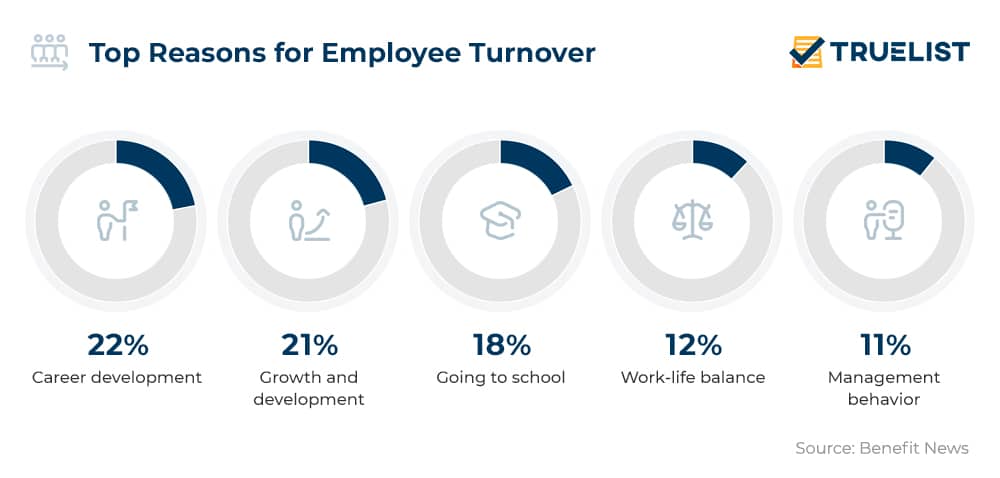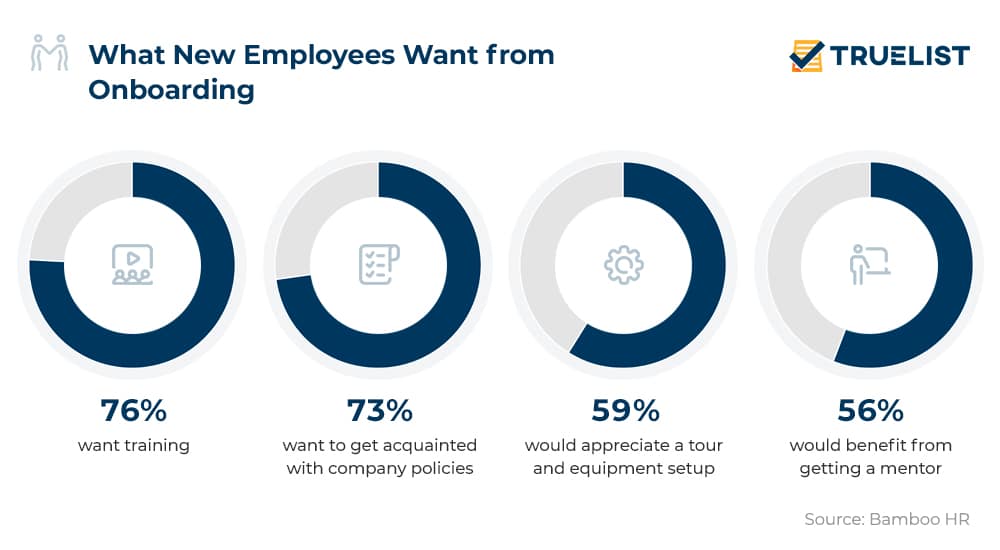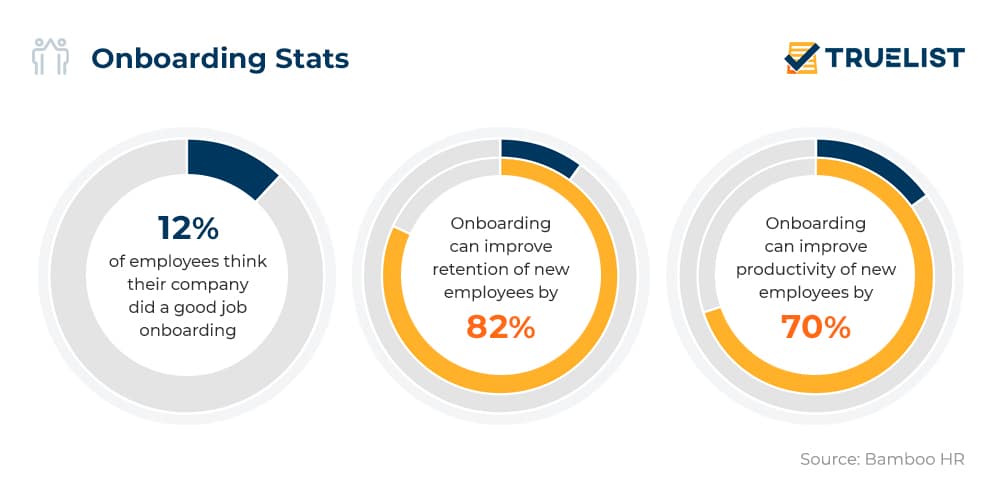It’s easy to look at employee retention statistics as just another percentage but in reality, they measure how much a company cares and is willing to put in the effort to keep its workforce from jumping ship. With loyal employees carrying up to 80% of the workload, the importance of employee retention cannot be overestimated.
While turnover is a natural occurrence and can’t be avoided in full, keeping it low will lower costs and boost productivity. That’s why we prepared the most essential stats and facts to show you how to keep your employees longer.
Employee Retention Stats (Editor’s Choice)
- Three to 4.5 million US employees quit each month. (Apollo Technical)
- 76% of new workers want the on-job training. (Bamboo HR)
- The cost of losing an employee is 33% of their annual salary. (Tiny Pulse)
- 6.2 million people left their jobs in September 2021 alone. (Zippia)
- Career development is the number one turnover reason for 22% of people. (Benefit News)
- Government services have the highest job retention rate. (Apollo Technical)
- 79% of people quit a job because of a lack of appreciation. (Tiny Pulse)
- There were 10.1 million job openings stateside as of June 2021. (Zippia)
- About 50% of people have left a job because of a bad manager. (Tiny Pulse)
- Only 16% of companies use technology to measure engagement. (HR Cloud)
Retention Statistics
1. One-third of new employees quit after six months.
Each month 3 to 4.5 million US workers quit their jobs. Up to 94% say would stay with the company they work at the moment if the organization would offer them more opportunities for learning, stats reveal.
(Apollo Technical)
2. 76% of new workers want to get training on the job.
Newly hired people need proper training to be able to start their new positions with confidence, training and employee retention statistics show. Unless that happens, chances are high they will leave within three to six months. Employee retention studies show there is a fine line between being introduced to the job and being overwhelmed by information and the HR departments need to keep that in mind.
(Bamboo HR)
3. Companies should target a turnover rate of 10% or less.
In general, a 90% retention rate is considered good. Factors causing turnover are most often lack of training, new opportunities, job advancement, bad communication, poor management, lack of recognition, and heavy workload, according to personnel retention facts. Employee retention rate statistics show the top personal turnover reasons are:
- Career development 22%
- Growth and development 21%
- Going to school 18%
- Work-life balance 12%
- Management behavior 11%
(Benefit News, Apollo Technical)

4. An average employee’s departure costs 33% of their annual salary.
Replacing employees has a hefty price tag, given the cost of advertising, recruiting, hiring, and training can reach a third or even half of one’s annual salary. Team retention is much more cost-effective and it has the added benefit of boosting morale, engagement, and productivity, employee engagement statistics show. The positive effects even include enhanced customer satisfaction, retention statistics suggest.
(Tiny Pulse, Apollo Technical)
5. A turnover rate of 19% is expected in many industries.
The Bureau of Labor Statistics reports that the retention span of employees earning wages was 4.6 years on average with their current employer. A good onboarding program ensures that 69% of employees stay on for at least three years. The estimate is that the average cost-per-hire of a new employee is $4,129.
(Apollo Technical)
6. A lack of management skills makes workers four times more likely to quit.
Employee loyalty statistics show that working for a good manager boosts job retention rates, with over 50% of people in a survey having quit a job because of their boss. Then, 56% believe managers get promoted too fast and before they are ready, and 60% say superiors need more management training.
40% of people that don’t think highly of their boss’s performance have been on job interviews in the past three months. Those that have a high opinion of their boss do so in only 10% of cases, employee retention statistics prove.
(Tiny Pulse)
7. On average, people change their careers when they are 39 years old.
The Work Institute’s Retention Report from 2017 revealed that 75% of employee turnover causes can be prevented. Stats show that employers can improve the staff retention rate by changing employee roles within the same company.
(Apollo Technical)
8. Retention stats show that government services have the highest retention rate.
Looking at total separations as a percent of annual average employment by industry, the situation looks like this:
- Government 18.6%
- Finance and insurance 24.6%
- Manufacturing and durable goods 28.6%
- Educational services 29.8%
- Wholesale trade 29.6%
The worst retention in the workplace measured by total separations can be found in:
- Arts, entertainment, and recreation 79.5%
- Leisure and hospitality 79%
- Accommodation and food services 78.9%
- Construction 65.0%
- Professional and business services 63.5%
(Apollo Technical)
9. 21.5% of employees that didn’t get recognition for a job well done have interviewed for a job in the last three months.
Employee retention stats show that recognition can go a long way to keeping staff on board, with only 12.4% that do feel recognized going job hunting. Around 24% of those that did not receive recognition from their direct superior in the last two weeks had already had another job interview. It’s no wonder then that 79% of people quit their jobs, citing “lack of appreciation”.
(Tiny Pulse)
10. Retention statistics show that 87% of HR managers see improved retention as critical in the next five years.
HR statistics conclusively show that most industry leaders realize the importance of employee retention and see that as a primary concern. They, however, also cite technology debt, lack of automation tools, as well as limited organizational support as roadblocks to keeping employees happy.
(Bonusly)
11. 92% of HR managers claim their top priority in 2021 was employee experience.
Some 17.42% of workers who quit their job will do so in the first month, and 16.45% of people quit their job within the first week. Another 14.48% of workers will stick only for six months. Retention stats show that HR software can help with the recruitment process and pave the road for successful onboarding, with the costs for turnover likely to more than offset the investment.
(Zippia, BambooHR)
12. 6.2 million people left their jobs in the US in September 2021 alone.
Stats further show that businesses lose just under a fifth (18%) of their workforce. The bulk of that (12%) is voluntary, with layoffs and terminations accounting only for 6%.
(Zippia)
13. Around 28% of new workers quit because the job is not what they want to do.
Another 26% quit because the job did not match their expectations set by the interview. Not liking the boss made people bounce fast in 23% of cases, underscoring the importance of good management for the retention of employees.
(BambooHR)
14. Employee retention rate statistics show employees are 23% more likely to stick to a job if their responsibilities and roles are clearly explained.
Employee retention research further shows that 21% want “more effective training” and 17% would appreciate a friendly smile or a helpful coworker. Onboarding statistics further show what new employees need when they first start out at a company:
- 76% want training
- 73% want to get acquainted with company policies
- 59% would appreciate a tour and equipment setup
- 56% would benefit from getting a mentor.
(Bamboo HR)

15. Merely 12% of workers say their company did a good job onboarding.
On the other hand, a successful onboarding can improve retention of new employees by 82% percent and productivity by at least 70%, employee retention statistics show. Onboarding software can play a key role since it is designed to introduce and connect new employees with the company and, as a result, can drastically reduce turnover within the first year.
(Cezanne HR, Bamboo HR)

16. Only 16% of companies use technology to measure employee engagement.
Employee engagement software tends to increase job satisfaction and keep high performers and talented workers well organized, happy, and less likely to change companies, employee retention rate statistics show. Such platforms can be of great help for the retention of employment.
(HR Cloud, Search HR Software)
In Conclusion
If a company is investing in keeping its employees from running to the competition, it means it cares. Even if it’s caring about the high cost of turnover, all the policies, strategies, and measures implemented must benefit the worker. And a happy, satisfied worker is more engaged, more productive, makes fewer errors and their overall job satisfaction is high. This results in good employment retention rates.
Employee retention statistics reveal such workers are the bringers of innovation and the driving force behind every high-performing team and having a loyal and talented employee base is the foundation of company stability.
FAQs
What is employee retention?
Employee retention is the ability of a company to keep its employees and prevent or reduce turnover. According to employee productivity statistics, retention impacts productivity and profit as well as workflow and the overall stability and coordination of the company and the teams within. Good retention often means engaged and happy workers with high job satisfaction, which means not only avoiding costs but getting better-than-average results, employee retention stats have proven.
(Netsuite, Tutorials Point)
What is a good employee retention rate?
Employee retention data shows that 90% is a good rate. Still, this depends on the industry. The highest retention can be found among government services and finance, while the lowest are in the food industry and retail.
(Great Game)
How do you calculate employee retention?
You need the number of employees you started with, then divide it by the number of employees that have stayed with you. Multiply the result by 100 and you will get the employee retention rate of your company.
(Lattice)
Why is employee retention important?
Employee retention statistics show that it saves the company money used for recruiting, hiking, and training. Also, productivity suffers greatly when the staff changes too frequently and the employment retention rate needs to be stable for teams to develop. Good retention strategies keep workers engaged which is another way to boost productivity and, by extension, profit.
(Netsuite)
What are retention strategies?
A good employee retention plan includes a series of measures employees can take to keep workers engaged, reduce turnover and avoid losing talented staff. Employee loyalty statistics show that strategies may differ but meeting your staff needs and reducing staff retention come first. Here are the best employee retention practices:
- Adequate pay
- Good working conditions
- Skilled recruiting
- Successful onboarding
- Work-life balance
- Benefits
- Bonuses
- Profit-sharing
(Netsuite, Simplicable)
What is an employee retention policy?
An employee retention policy is a set of employee retention strategies and measures a company has in place to retain its workers. Employee retention stats show that introducing benefits and perks, alongside good communication with employees, is a good place to start when fighting turnover.
(Koppr)
What are the objectives of employee retention?
The objectives of employee retention are: keeping talented workers within the company, not losing skilled staff to competition, reducing the cost of hiring and training new employees, and making sure workflow isn’t interrupted due to frequent team changes. All of it is more expensive than the cost of an employee retention strategy.
(Tutorials Point, Insala)
What are the factors affecting employee retention?
While there are a lot of employee retention factors, let’s have a look at the six most important singled out by employee retention statistics:
- Onboarding and training
- Flexibility
- Financial insecurity
- Work-life balance
- Management
- Recognition
(Rippl)
Who is responsible for employee retention?
Although HR departments play a key role in keeping employees in the company by using retention strategies and taking care of employees, they are not the only ones managing employee retention. Many workers quit within the first year, so employee retention statistics suggest that management — both mid- and C-level — bear responsibility as well.
(HR Bartender, Tutorials Point, Management Study Guide)
Sources: Apollo Technical, Bamboo HR, Benefit News, Tiny Pulse, Bonusly, Zippia, Cezanne HR, HR Cloud, Search HR Software, Netsuite, Tutorials Point, Great Game, Lattice, Netsuite, Simplicable, Koppr, Tutorials Point, Insala, Rippl, HR Bartender, Tutorials Point, Management Study Guide

